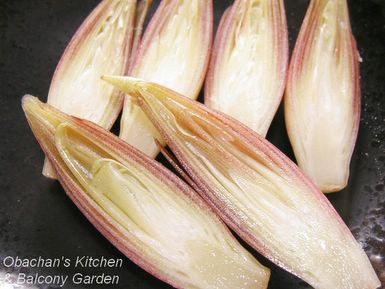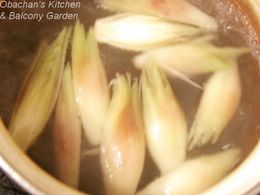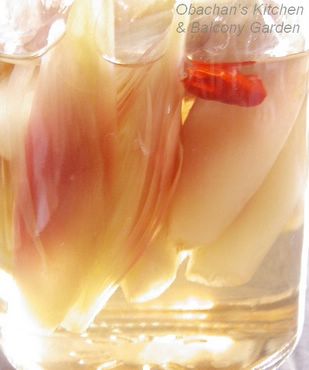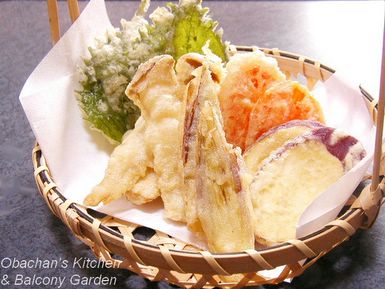
Myoga ginger -- Aren't They Photogenic? --
Myoga ginger always reminds me of summer, but actually autumn is another myoga season. Inspired by bilbo’s recent comments, I bought some today and tried a few dishes that I haven't made for a long time.
To be perfectly honest, I hated myoga so much when I was a kid. I would go on a hunger strike when my mom secretly put some in the miso soup. ;P Now I can live with miso soup with myoga, but still today, I really need to force myself to eat the thin strips of raw myoga placed on top of cold noodles as a condiment. I guess I can really enjoy myoga in only 3 dishes: sweet & sour pickles, salad with sumiso (vinegar-miso) dressing and tempura.
Sweet and Sour Myoga Pickles
5 to 6 myoga
100 ml vinegar
1/2 Tbsp salt
50 g sugar
50 ml mirin (rice wine)
Red chili pepper (1cm long)
 Cut myoga in half (lengthwise), sprinkle with salt and leave 15 to 20 minutes. Combine vinegar, sugar, and mirin in a saucepan, add chili pepper and bring to boil. Remove from heat and let cool. Blanch myoga in boiling water for 2 to 3 minutes. Drain and cool for apx. 15 min. Soak myoga in the sweet & sour mixture overnight. Cut myoga in half (lengthwise), sprinkle with salt and leave 15 to 20 minutes. Combine vinegar, sugar, and mirin in a saucepan, add chili pepper and bring to boil. Remove from heat and let cool. Blanch myoga in boiling water for 2 to 3 minutes. Drain and cool for apx. 15 min. Soak myoga in the sweet & sour mixture overnight.
The outer layer will turn into pretty reddish pink in vinegar. It’s really pretty and will be prettier on the next day.

Sweet & Sour Myoga Pickles
 When I make tempura, I always use several different ingredients; I almost never make one-ingredient-only tempura. Today I used a sweet potato, eringi mushrooms, green perilla leaves and carrot (not included in the pic above) in addition to myoga. When I make tempura, I always use several different ingredients; I almost never make one-ingredient-only tempura. Today I used a sweet potato, eringi mushrooms, green perilla leaves and carrot (not included in the pic above) in addition to myoga.
 For tempura, you can just cut myoga in half and batter-fry. Its tangy flavor becomes a lot milder when fried. If you really want to get rid of the tanginess, I'm not very sure but soaking halved myoga in water beforehand for 5 to 10 minutes might help a little ... (or maybe not... ) Anyway, if myoga was soaked in water beforehand, it needs to be drained well and pat-dried with a paper towel before being batter-fried. For tempura, you can just cut myoga in half and batter-fry. Its tangy flavor becomes a lot milder when fried. If you really want to get rid of the tanginess, I'm not very sure but soaking halved myoga in water beforehand for 5 to 10 minutes might help a little ... (or maybe not... ) Anyway, if myoga was soaked in water beforehand, it needs to be drained well and pat-dried with a paper towel before being batter-fried.
I love eating myoga tempura with ten-tsuyu (dipping sauce made from dashi stock, soy sauce and mirin). But when I feel that the myoga is still too strong, I sometimes dip the tempura in ten-tsuyu first and then dip the top of if in mayonnaise and eat. This way the mayonnaise reduces the pungency of myoga some more and makes it taste milder.

Tempura
One more dish. I didn't make this today, but myoga is good with sumiso (vinegar-miso) dressing. Here's a recipe for the dressing.
Sumiso Dressing
2 Tbsp miso
2 Tbsp vinegar
1 Tbsp mirin (rice wine)
2 tsp sugar
2 tsp sake (or dashi stock)
Combine all ingredients and blend well to dissolve miso completely. Dress sliced myoga with sumiso dressing and serve.
* Miso and vinegar can hide the tanginess to a good extent, but again, if you still want it less tangy, soaking in water or blanching beforehand may help, though blanching would really ruin the crispness. If blanched, cool completely before serving with sumiso dressing.
I like sweet & sour pickles the best. I think that is the friendliest one for most myoga beginners. ;)
|
![]()

![]()
13 comments:
Hi Obachan,
I'm pretty sure these are what we called bunga kantan (wild/torch ginger flowers) in Malaysia. I have lots of wild/torch ginger trees at the backyard garden of my family home. We use kantan as an ingredient for kerabu (traditional Malay salad), asam (sour) curries and asam laksa.
Check out these links and recipes in your spare time:
Torch Ginger
Asam Pedas (Spicy Sour Curry)
Nasi Goreng Kerabu (Fried Rice with Traditional Malay Salad)
Nasi Kerabu (Rice with Traditional Malay Salad)
Nasi Ulam (Traditional Malay Salad Rice)
Fish Tempoyak
Young Papaya Kerabu with Wild Ginger Flower
Crab Laksa
Nyonya Asam (Sour) Curry Fish
Hard to find English words that describe kerabu and ulam. Hence, I called them both (traditional) salad.
Interesting to see that you have them as pickle and tempura. Shall try to make some kantan tempura one day :)
arigato gozaimasu obachan,
the myoga pickles look way too good. thanks for posting the recipes. Now as soon as I can get my hands on some mirin , I'll try making em and let u know how they turn out. Thanks once again.
Take care
Oh my!!! Gorgeous pictures! I just today discovered your blogs while searching for Tosa-style restaurants in Tokyo and I'm so excited now! Your recipes all sound so yummy and the photos are beautiful.
My husband is originally from Kochi and loves his home-town foods.
obachan,
your tenpura looks perfect - like and lace-y. how do you do it? my batter always fries up hard and crunchy and brown!
Amber Amethryne
Oh, thanks for the links! Your torch ginger and our myoga may not be exactly the same, but must be very close. (I linked to the photos on this site.) It’s interesting that you call it “kantan,” because in Japanese it means “easy.” :) Nashi Ulam looks very tempting, though I won’t be able to find almost half of the ingredients around here.
Sara
The idea of posting about the sauces in my fridge sounds really hilarious! :D Ok, I’ll give it a try sometime soon. I guess bilbo may find it handy, too. Just give me some time, OK? I can give you a bit of info. about mirin here. It’s often translated as “rice wine” and made from glutinous rice, malted rice and shochu (distilled spirit). It contains apx. 13 – 14% alcohol and apx. 40% sugar and its color is similar to vinegar. We use it for things like simmered food, teriyaki, etc. It’s essential for giving sweetness and glossy sheen to teriyaki-type of dish.
bilbo
Have fun and good luck! Oh, in case you wonder when you buy mirin at the store – there’s a cheaper substitute for mirin available at stores called “mirin-fu (mirin-like)” seasoning. It’s almost the same thing as mirin but with less alcohol content and more sugar content.
Mava
What a coincidence!! It sure is a small world, isn’t it? I’m so happy that you found my blog. I’ll keep posting about lots of Kochi stuff. Hope you keep coming back (with your husband, maybe?) ;)
rae
Honestly, I’m no tempura batter expert, but I guess I did a good job this time. Basically, what I do is almost the same as the “Tips for Making Crispy Tempura” here.
To add to those tips, I often use eggyolk only and be really careful not to make the batter too thick. They always say things like “use chopsticks and move them as if you are ‘cutting’ the flour-water mixture. It’s OK to leave little lumps of flour. ” And I try not to cover the veg. chunks with the batter completely --- when I think I got too much batter on the ingredient, I wipe of some of it with my fingers so that the color of the ingredients will show. But still, it often doesn’t work. When everything worked out somehow, like a miracle, the batter turns out lace-y but crispy, not too fluffy, even after it gets cold. It happens about once a year. :P
obachan konnichiwa
Just tried the myoga pickle and it tastes really good to me. Thanks once again.
Hi bilbo,
I'm so glad that your liked myoga pickles. I already ate up mine. ;)
Obachan, your tempura look so perfect, I've never cooked them that beautifully! I think I'm going to try growing myoga and shiso next year, I'll let you know how it goes :)
Hi keiko,
Thank you, but I didn’t do a good job with eringi tempura this time, to be honest. I guess I overcooked them, though they don't look brown at all in the photo.
mmmmmmmm, that rich food, in this moment I have so hungry that I'll fix that now.
hi
This ginger looks delicious!
Post a Comment